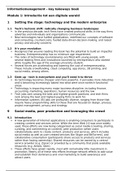Informatiemanagement - key takeways boek
Module 1: Introductie tot een digitale wereld
1 Setting the stage: technology and the modern enterprise
1.1 Tech’s tectonic shift: radically changing business landscapes
In the previous decade, tech firms have created profound shifts in the way firms
advertise and individuals and organizations communicate
New technologies have fuelled globalization, redefined our concepts of software
and computing, crushed costs, fuelled data-driven decision-making, and raised
privacy and security concerns
1.2 It’s your revolution
Recognize that anyone reading this book has the potential to build an impactful
business. Entrepreneurship has no minimum age requirement.
The ranks of technology revolutionaries are filled with young people, with
several leading firms and innovations launched by entrepreneurs who started
while roughly the age of the average university student.
Several forces are accelerating and lowering the cost of entrepreneurship.
These include crowdfunding, cloud computing, app stores, 3D printing, and
social media, among others.
1.3 Geek up - tech is everywhere and you’ll need it to thrive
As technology becomes cheaper and more powerful, it pervades more industries
and is becoming increasingly baked into what were once nontech functional
areas.
Technology is impacting every major business discipline, including finance,
accounting, marketing, operations, human resources and the law
Tech jobs rank among the best and highest-growth positions, and tech firms
rank among the best and highest-paying firms to work for.
Information systems (IS) jobs are profoundly diverse, ranging from those that
require heavy programming skills to those that are focused on design, process,
project management, privacy and strategy
9 Social media, peer production and leveraging the crowd
9.1 Introduction
A new generation of Internet applications is enabling consumers to participate in
creating content and services online. While the term Web 2.0 was once widely
used, these efforts are now being categorized as social media (creating, sharing,
curating, and commenting on content), peer production (when users
collaboratively work to create content, products and services, which includes
social media as well as user-created services like Skype and BitTorrent), and
collaborative consumption (participants share access to products and services
rather than having ownership). Shared resources can be owned by a central
service provider (e.g. Zipcar) or provided by a community that pools available
resources (e.g. Airbnb, Uber).
These efforts have grown rapidly, most with remarkably little investment in
promotion. Nearly all of these new efforts leverage network effects to add value
and establish their dominance and viral marketing to build awareness and
attract users.
, Many of these services often leverage the wisdom of crowds to provide insight,
products, or ideas that can be far more accurate or valuable than those
provided by a smaller group of professionals. Question-and-answer sites like
Quora and Stack Overflow are both learning tools and methods to establish
one’s reputation and authority while helping the broader user community.
Microblogging is a channel for sharing and consuming short pieces of content.
The category is dominated by Twittter, although many private and public
services exist.
Services aren’t limited to consumer use. Firms advertise, promote, and engage
with customers over social networks. Other tools, such as Slack, Stack Overflow
and GitHub are considered essential in many modern enterprises.
Messaging services have exploded with the advent of mobile devices. Many
efforts are now preferred to SMS and offer rich exchange of media,
specialization in a media topic, public or private postings, and public or
anonymous identities
Network effects play a heading role in enabling these efforts. Many of these
services also rely on ad-supported revenue models and open source software.
9.2 Blogs
Blogs provide a rapid way to distribute ideas and information from one writer to
many readers
Search engines, social media sharing, and trackbacks allow a blogger’s
community of readers to spread the word on interesting posts and help
distinguish and reinforce the reputations of widely read blogs
The comments section in blogs can create a conversation to gather opinion, vet
ideas, and brainstorm. Public commentary can also apply pressure to correct
inaccuracies and keep a blogger honest
Well-known blogs can be powerfully influential, acting as flashpoints on public
opinion
Firms ignore influential bloggers at their peril, but organizations should also be
cautious about how they use and engage blogs and avoid flagrantly promotional
or biased efforts
Senior executives from several industries use blogs for business purposes,
including marketing, sharing ideas, gathering feedback, press response, image
shaping, and reaching consumers directly without press filtering
Blogs are a type of owned media, but when users online share blog posts form
an organization, this constitutes a type of earned media that generates even
more awareness at no additional cost
Effective blogs can improve a firm’s SEO (search engine ranking results),
making the firm easier to find and possibly pushing online visibility ahead of
rivals
9.3 Wikis
Wikis can be powerful tools for many-to-many content collaboration, and can be
ideal for creating resources that benefit from the input of many, such as
encyclopaedia entries, meeting agendas, and project status documents.
The greater the number of wiki users, the more likely the information contained
in the wiki will be accurate and grow in value
Wikis can be public or private
The availability of free or low-cost wiki tools can create a knowledge
clearinghouse on topics, firms, products and even individuals. Organizations can
seek to harness the collective intelligence (wisdom of crows) of online
communities, and create a living knowledge repository. The openness of wikis
, acts as a mechanism for promoting organizational transparency and
accountability.
9.4 Social networks
Electronic social networks help individuals maintain contacts, discover and
engage people with common interest, share updates and organize as groups.
Modern social networks are major messaging services, supporting private one-
to-one notes, public postings, and broadcast updates or feeds.
Social networks also raise some of the strongest privacy concerns, as status
updates, past messages, photos and other content linger, even as a user’s
online behaviour and network of contacts changes.
Network effects and cultural differences result in one social network being
favoured over others in a particular culture or region.
Information spread virally via news feeds. Feeds can rapidly mobilize
populations and dramatically spread the adoption of applications. The flow of
content in social networks is also difficult to control and sometimes results in
embarrassing public disclosures.
Feeds have a downside, and there have been instance where feed
mismanagement has caused user discontent, public relations problems, and the
possibility of legal action.
The use of public social networks within private organizations is growing, and
many organizations are implementing their own, private, social networks.
Linkedin is seen as a key recruiting, contact maintenance, and learning tool,
while corporate messaging tools like Slack are used to increase employee
productivity.
Firms are also setting up social networks for customer engagement and mining
these sites for customer ideas, innovation, and feedback.
9.5 Twitter and the rise of microblogging
While many public and private microblogging services exist, Twitter remains by
far the dominant service.
Unlike status updates found on services like Facebook and LinkedIn, Twitter’s
default supports assymetric communication, where someone can follow updates
without first getting their approval. This function makes Twitter a good choice
for anyone cultivating a following - authors, celebrities, organizations and brand
promotors.
You don’t need to tweet to get value. Many Twitter users follow friends, firms,
celebrities, and thought leaders, quickly gaining access to trending topics.
Twitter hashtags (keywords preceded by the # character) are used to organize
“tweets” on a given topic. Users can search on hashtags, and many applications
allow for tweets to be organized and displayed by tag.
Organizations are leveraging Twitter in a variety of ways, including for real-time
promotions, for time-sensitive information, for scheduling and yield
management, for customer engagement and support, for promotion, for
intelligence gathering, for idea sourcing, and as a sales channel.
Like other forms of social media, Twitter can serve as a hot house that attracts
opinion and forces organizational transparency and accountability.
Activists have leveraged the service worldwide, and it has also served as an
early warning mechanism in disasters, terror, and other events.
Twitter will surface tweets and its algorithms think you’ll be most interested in.
Because of this, many feel Twitter is more friendly and conducive for organic
media sharing. Twitter also sells ad products, including video advertisements
and custom hashtag-linked emojis, to increase the reach of posts and to recruit
new followers.






